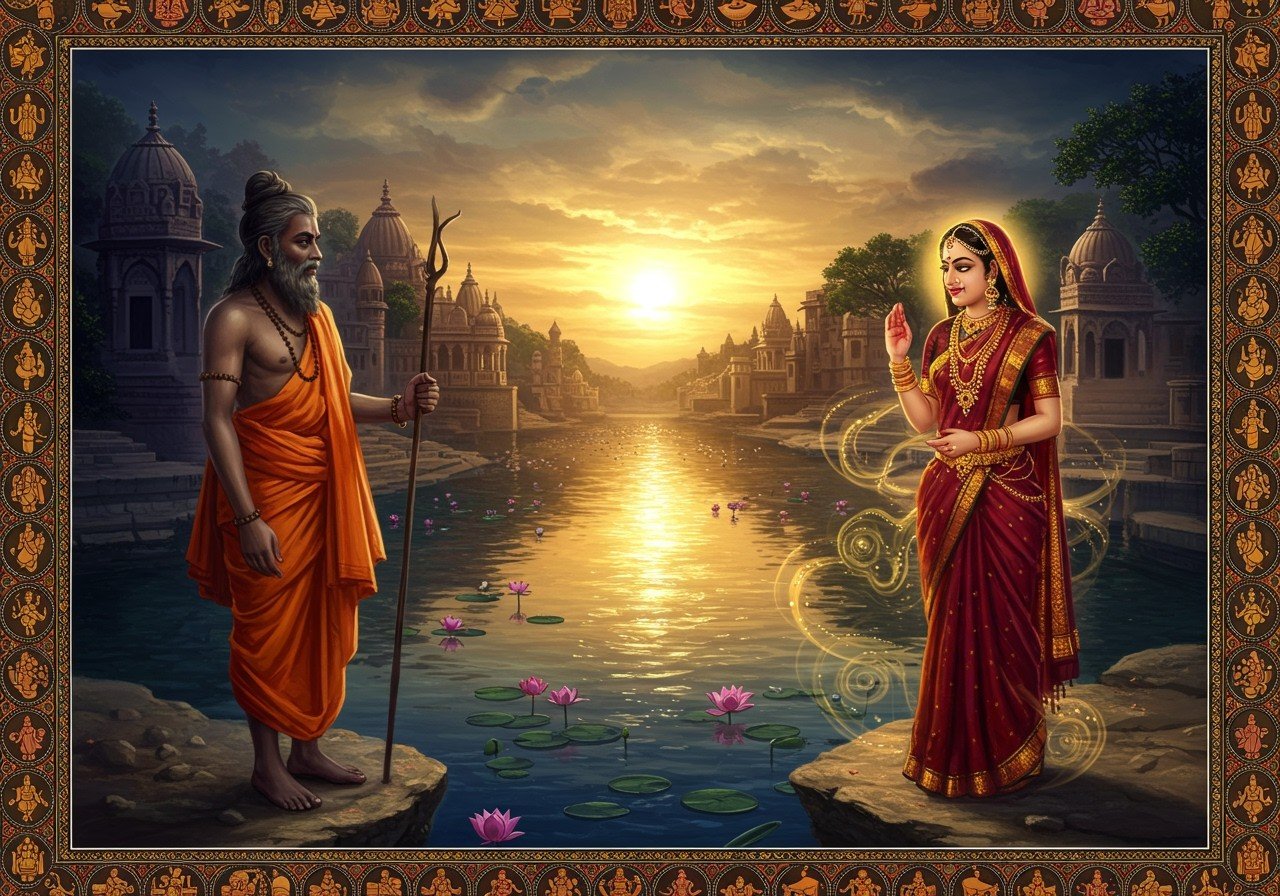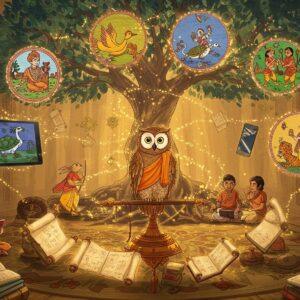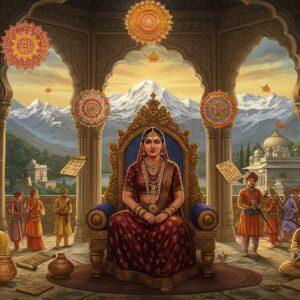
The Mahabharata, a timeless epic, interweaves complex relationships and profound narratives. Central to this epic is the intricate bond between Vyasa, the revered sage and author of the Mahabharata, and his mother, Satyavati. This exploration delves into their unique familial ties and the significant impact of their interactions within the epic’s narrative.
Satyavati’s Humble Beginnings and Divine Lineage
Satyavati’s story unfolds on the banks of the Yamuna River. Born to a fisherman chieftain, Dasharaja, she was known as Matsyagandha due to a distinctive fishy scent. Her lineage, however, held a divine secret. As the daughter of King Vasu of Chedi and an Apsara named Adrika, who was cursed to become a fish, her life was destined for an extraordinary path. Despite her humble upbringing, Satyavati’s destiny took a dramatic turn when she captured the heart of King Shantanu and became his queen.
The Divine Encounter with Parashara and the Birth of Vyasa
Sage Parashara’s encounter with Satyavati was a pivotal moment. While ferrying him across the river, he was captivated by her presence. In a divine intervention, Parashara granted her a boon, transforming her scent into the sweet fragrance of jasmine, forever altering her path. From their union, Vyasa, also known as Krishna Dwaipayana, was born on an island in the Yamuna, setting the stage for the epic events to unfold. Vyasa, remarkably, was born fully grown and left his mother soon after, promising to return when needed. This miraculous birth and his immediate departure underscore the divine nature of Vyasa’s existence.
Vyasa: The Sage of Wisdom and Prophecy
Vyasa’s birth was imbued with divine purpose. Renowned for his wisdom and as the compiler of sacred texts, including the Vedas and the Mahabharata itself, Vyasa’s presence is paramount. His role transcends mere authorship; he is a guiding force, a seer, and a sage throughout the epic narrative. His very name, meaning ‘compiler’ or ‘arranger’, signifies his invaluable contributions to Hindu literature and philosophy.
A Nuanced Relationship Bound by Duty and Respect
The bond between Vyasa and Satyavati is multifaceted, characterized by deep respect and unwavering duty. Vyasa consistently fulfilled his promises to his mother, navigating complex cultural expectations with grace and wisdom. This relationship exemplifies the delicate balance between personal obligations and familial responsibility within the constraints of ancient traditions. Key moments, such as Vyasa’s role in ensuring the continuation of the Kuru lineage, underscore their profound connection.
Satyavati’s Pivotal Decisions and the Kuru Dynasty
Satyavati’s influence on the Mahabharata is undeniable. Confronted with a dynastic crisis after the untimely deaths of her sons Chitrangada and Vichitravirya, she turned to Vyasa. Her decision to invoke the practice of Niyoga, asking Vyasa to father children with Vichitravirya’s widows, Ambika and Ambalika, was driven by her unwavering determination to preserve the Kuru dynasty. This difficult decision highlights Satyavati’s strength and pragmatism as both a queen and a mother, prioritizing the future of her lineage.
Vyasa’s Enduring Legacy: Shaping Dharma and Hindu Thought
Vyasa’s legacy extends far beyond his familial ties. His profound contributions to Hindu philosophy, literature, and spiritual thought continue to resonate through the ages. As a sage, his teachings and insights remain a source of wisdom and guidance. Through his narration and compilation of the Mahabharata, Vyasa became a preserver of dharma, offering timeless lessons on righteousness, duty, and the complexities of human existence. Explore a comparative study of the epics on Poojn.in to deepen your understanding.
Poojn.in: Connecting You to Sacred Knowledge
At Poojn.in, India’s leading cultural goods and services store, we offer a curated selection of items to support your exploration of the Mahabharata’s wisdom. Deepen your understanding of Vyasa’s teachings with our collection of Bhagavad Gitas, available in various languages and editions. Enhance your personal rituals with authentic puja items and explore our diverse selection of spiritual books.
Conclusion: A Timeless Connection of Duty, Love, and Destiny
The story of Vyasa and Satyavati is a powerful narrative woven into the fabric of the Mahabharata. Their journey, from Satyavati’s humble beginnings to Vyasa’s legacy as a revered sage, showcases the strength and resilience of familial bonds amidst extraordinary circumstances. Their choices and actions, driven by duty, love, and destiny, profoundly shaped the course of the epic and the fate of the Kuru dynasty. Reflecting on their tale offers timeless lessons, inspiring us to honor our own traditions, embrace our responsibilities, and navigate the complexities of life with wisdom and grace.
FAQs: Understanding the Complexities of Vyasa and Satyavati’s Relationship
Who was Vyasa to Satyavati? Vyasa was Satyavati’s firstborn son, born before her marriage to King Shantanu, from her union with Sage Parashara. This makes their relationship complex, as Vyasa also plays a crucial role in ensuring the continuation of Satyavati’s royal lineage through her later marriage.
How did Vyasa come into Satyavati’s life? As a young maiden ferrying people across the river, Satyavati encountered Sage Parashara. He, captivated by her, granted her a boon and fathered Vyasa, who was born fully grown and possessing immense wisdom.
Why is their relationship considered complex? The complexity arises from Vyasa’s dual role as both Satyavati’s son and the person responsible for fathering her grandchildren through Niyoga with her daughters-in-law, Ambika and Ambalika, after the deaths of her sons Chitrangada and Vichitravirya. This unusual circumstance creates an intricate dynamic between mother and son.
What role did Vyasa play in the royal family of Hastinapura? Vyasa played a critical role in securing the future of the Kuru dynasty by fathering Dhritarashtra, Pandu, and Vidura. These sons ensured the continuation of the royal lineage despite the untimely deaths of Satyavati’s sons with King Shantanu.
Was Vyasa always present in Satyavati’s life? No. Vyasa spent much of his life in solitude, dedicated to meditation and spiritual practices. However, he dutifully returned to his mother’s aid when she summoned him to fulfill his promise and address the crisis of succession within the Kuru dynasty.
Did Satyavati have other children besides Vyasa? Yes. Satyavati had two sons with King Shantanu, Chitrangada and Vichitravirya. Their premature deaths without heirs led to the pivotal decision involving Vyasa and the practice of Niyoga.
How did Vyasa’s presence affect Satyavati’s life? Vyasa’s presence was deeply impactful. He secured the continuation of the Kuru lineage, ensuring Satyavati’s legacy within the royal family despite the tragic loss of her sons with King Shantanu. His actions demonstrate the powerful influence of dharma and familial duty within the Mahabharata.


